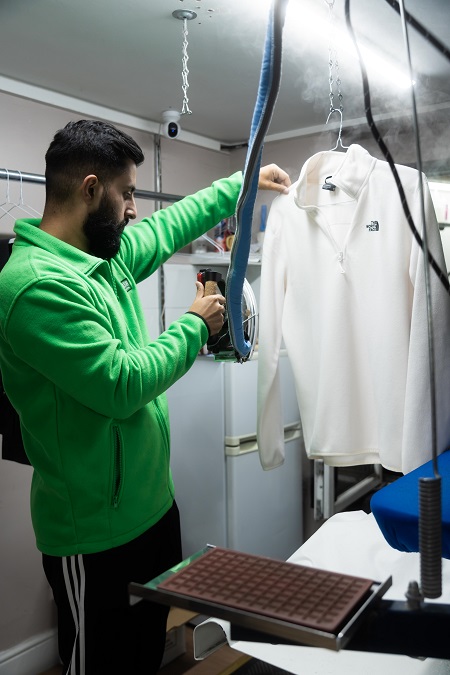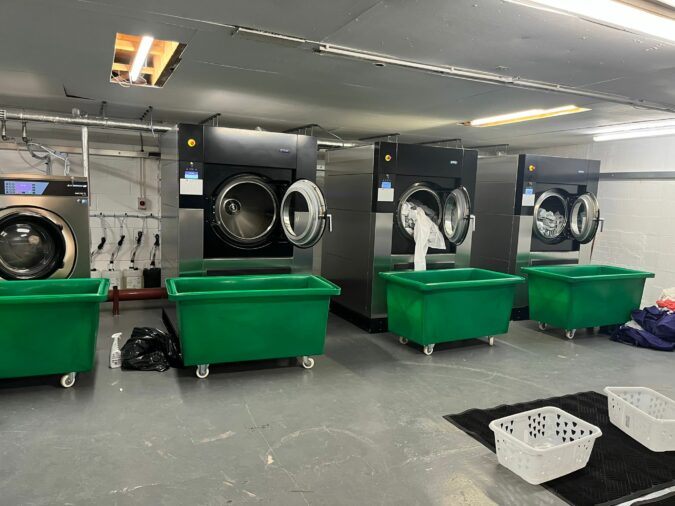How Dry Cleaners Work
Understanding how dry cleaners work is crucial in debunking the many myths that surround this essential service. Often, people believe that dry cleaning is only for delicate or expensive garments. However, it offers a lot more benefits that make it suitable for a wide range of clothing and fabrics.
Firstly, dry cleaning is more than just cleaning; it’s a careful process that preserves the quality and extends the life of your clothes. Unlike traditional washing, it doesn’t involve water. Instead, it uses special solvents to remove dirt and stains without harming the fabric. This method is especially beneficial for materials that can degrade or shrink in water.
Moreover, knowing how dry cleaners operate helps you appreciate the gentle care they take with every item. This process is not just about stain removal; it’s about maintaining the shape, color, and texture of your garments.
By clearing up misconceptions, you can make informed decisions about clothing care. In the next section, we’ll bust some common myths about dry cleaning, shedding light on the facts to help you take better care of your wardrobe.

Myth 1: Dry Cleaning Is Just for Special Occasions
Debunking the Formal Wear Only Myth
Contrary to popular belief, dry cleaning is not limited to just formal wear or expensive garments. Let’s bust this myth wide open and reveal how versatile dry cleaning truly is.
A Wide Range of Suitable Items:
- Everyday Wear: Suits and dresses that are worn regularly can benefit immensely from dry cleaning. The process helps maintain the garment’s integrity and appearance without the wear and tear of a standard wash.
- Home Textiles: Items like bedding and curtains, often overlooked, are perfect candidates for dry cleaning. This method helps preserve their quality and extend their lifespan, keeping them fresh and vibrant for longer.
How Dry Cleaners Care for Everyday Garments
Understanding how dry cleaners work reveals why it’s an excellent choice for a variety of items, not just those reserved for special occasions. The process involves meticulous steps tailored to protect and clean effectively without the harsh impacts of conventional washing.
- Gentle Solvents: Modern dry cleaners use environmentally friendly solvents, such as liquid carbon dioxide, which are gentle on clothes but tough on dirt and stains. This approach ensures that your everyday garments are cleaned without risking damage.
- Preservation of Quality: By avoiding water, dry cleaning prevents shrinkage, fading, and texture loss, which are common issues in machine washing. This method is especially beneficial for delicate fabrics that need extra care.
Convenience and Affordability:
- Many dry cleaners offer services like same-day or next-day returns, making it a convenient option for those with a busy schedule.
- Contrary to the myth that dry cleaning is expensive, many services are quite affordable. Discounts and special offers are frequently available, making it a practical choice for maintaining both high-end and everyday garments.
By dispelling the myth that dry cleaning is only for special occasions, we open up a world of possibilities for taking better care of a wide array of garments. Whether it’s a silk blouse or a cotton suit, dry cleaning has a place in the routine care of your wardrobe, proving its value far beyond the occasional wear.
Myth 2: Dry Cleaning Shrinks Clothes
Understanding the Materials and Fabrics Processed by Dry Cleaners
The belief that dry cleaning causes clothes to shrink is widespread but unfounded. Dry cleaning is, in fact, designed to care for and preserve fabrics. Here’s a look at how dry cleaning accommodates a variety of materials:
- Delicate Fabrics: Silk, wool, and linen are prime examples of materials that benefit from dry cleaning, as water can cause these fabrics to shrink or distort.
- Blended Fabrics: Items that blend natural and synthetic fibers are also well-suited to dry cleaning, which maintains the integrity of different materials within the same garment.
How Dry Cleaning Technology Prevents Shrinkage
Dry cleaning involves sophisticated techniques that protect and clean clothes without the risks associated with traditional washing. Here’s how the process works:
- Solvent Use: Unlike water, the solvents used in dry cleaning do not penetrate fabric fibers in a way that causes them to expand and contract. Solvents like liquid carbon dioxide are particularly effective in cleaning without altering the fabric structure.
- Controlled Cleaning Environment: Dry cleaning machines are specifically designed to maintain a consistent cleaning environment. This controlled setting prevents temperature fluctuations and mechanical actions that typically lead to shrinkage in conventional washers.
Key Benefits of Dry Cleaning:
- Preserve Shape and Texture: The gentle nature of dry cleaning, free from harsh tumbling and water saturation, helps retain the original shape and texture of garments.
- Enhances Color Retention: Solvents in dry cleaning are less likely to cause colors to fade, ensuring that clothes look vibrant after multiple cleans.
By debunking the myth that dry cleaning shrinks clothes, we reveal its true advantage: a careful, precise method that extends the life of your garments. This understanding allows you to trust dry cleaning with much more than just the occasional fancy outfit, including everyday wear that requires gentle care.
Myth 3: Dry Cleaning Removes All Stains
The Chemical Process and Solvents Used in Dry Cleaning
Dry cleaning is a sophisticated method that uses specific chemicals to clean clothes without water. Understanding the solvents and processes used can help set realistic expectations about stain removal.
- Solvents Explained: The most common solvent used is perchloroethylene, known for its effectiveness in removing grease and oil. More environmentally friendly options, like liquid carbon dioxide, are also widely used due to their lower ecological impact.
- How Solvents Work: These chemicals dissolve stains from fabrics during the cleaning cycle. The solvents penetrate deep into the fibers to loosen dirt, oils, and stains without the need for water or aggressive washing.
Tackling Different Stains
While dry cleaning is excellent for many types of stains, it’s not a guaranteed solution for all. Here’s why some stains may persist even after professional treatment:
- Nature of Stains: Water-soluble stains, such as fruit juice or blood, can be challenging for dry-cleaning solvents to remove completely. These might require special water-based pre-treatments.
- Set-In Stains: Stains that have been on clothing for a long time or have been subjected to heat can set into the fabric, making them more difficult to remove regardless of the cleaning method used.
- Fabric Sensitivity: The type of fabric also plays a crucial role in how well stains can be removed. Delicate fabrics may not withstand the treatments needed to remove tougher stains.

Key Points to Remember:
- Pre-Treatment Processes: For challenging stains, dry cleaners often apply specific pre-treatments to break down stains before the dry cleaning cycle.
- Professional Expertise: Dry cleaners assess the nature of each stain and fabric type, applying the most suitable method to achieve the best results without damaging the garment.
Understanding the capabilities and limitations of dry cleaning helps in managing expectations and appreciating the craft of professional garment care. While dry cleaning provides significant benefits in maintaining and cleaning clothes, it’s essential to recognize that not all stains can be completely removed.
Myth 4: Dry Cleaning Is Bad for the Environment
Traditional vs. Modern Eco-Friendly Solvents
The idea that dry cleaning is harmful to the environment stems from the use of traditional solvents like perchloroethylene (PERC), which has been a standard in the industry due to its effectiveness in stain removal. However, the narrative is changing as the industry shifts towards more sustainable practices.
- PERC: Historically used for its powerful cleaning capabilities, PERC has been criticized for its environmental and health impacts. This solvent can contribute to air and groundwater pollution if not handled properly.
- CO2 Cleaning: A revolutionary alternative, liquid carbon dioxide cleaning uses non-toxic, non-flammable CO2 as the cleaning solvent. CO2 cleaning is praised for its environmental safety, effectively reducing the ecological footprint of dry cleaning.
How Dry Cleaners Are Evolving to Reduce Environmental Impact
Dry cleaners are increasingly adopting greener practices to minimize their environmental impact. Here’s how the industry is evolving:
- Wet Cleaning: Considered one of the most environmentally friendly methods, wet cleaning uses water and specialized detergents that are milder than traditional dry cleaning chemicals. This method is safe for both the environment and delicate fabrics.
- Recycling Solvents: Many dry cleaning businesses now use distillation units to recycle and reuse solvents, significantly reducing waste and hazardous emissions.
- Energy-Efficient Equipment: Adoption of more efficient machinery helps reduce energy consumption, further lowering the carbon footprint of dry cleaning operations.
Key Environmental Benefits:
- Reduced Chemical Use: Transitioning to greener solvents means fewer chemicals are released into the environment, aligning with global sustainability goals.
- Lower Energy Consumption: Modern machines and practices not only clean clothes more efficiently but also conserve energy.
By debunking the myth that dry cleaning is inherently bad for the environment, we can appreciate the industry’s efforts to adopt safer and more sustainable methods. This shift not only helps protect our planet but also ensures that the practice of dry cleaning can continue without compromising environmental integrity.
Myth 5: All Dry Cleaners Are the Same
Factors That Differentiate Dry Cleaning Services
The notion that all dry cleaners offer a uniform service is a common misconception. Several key factors set apart the services provided by different dry cleaners, ensuring varied experiences and results.
- Technology: Advanced machines can handle delicate fabrics more gently and efficiently, reducing wear and tear during the cleaning process.
- Solvents: The choice of cleaning solvents greatly impacts both the effectiveness of stain removal and the environmental footprint. Eco-friendly options like liquid carbon dioxide or silicone-based solvents offer a greener alternative to traditional PERC.
- Staff Expertise: The knowledge and experience of the staff play a crucial role in the care and handling of garments. Expert cleaners can effectively treat difficult stains and offer advice on garment care.
Choosing the Right Dry Cleaner
Selecting a dry cleaner shouldn’t be a hasty decision. Here’s how you can choose a service that best suits your needs based on their machines and methods:
- Check for Green Credentials: Opt for dry cleaners that use environmentally safe solvents and practices. This not only supports sustainable operations but also ensures gentler treatment for your garments.
- Assess the Technology Used: Inquire about the type of cleaning technology in use. Modern, sophisticated equipment typically offers better cleaning and less risk of fabric damage.
- Evaluate Expertise: Experienced staff are more likely to provide high-quality service and handle complex cleaning challenges. Don’t hesitate to ask about the staff’s training and experience in the industry.
Key Considerations:
- Service Variety: Some dry cleaners specialize in certain types of garments or fabrics. Knowing this can help you choose the best cleaner for your specific needs.
- Turnaround Time: For those needing quick service, check if the cleaner offers same-day or next-day service.
Understanding these differences can help debunk the myth that all dry cleaners are the same, guiding you to make informed choices about where to bring your valuable garments. By selecting the right cleaner, you ensure the best care for your clothes, enhancing their longevity and appearance.
Using Dry Cleaning Services Wisely
Knowing when to use dry cleaning services and how to communicate effectively with your dry cleaner can significantly enhance the care and longevity of your garments.
Tips for Consumers on What to Dry Clean vs. What to Wash at Home
Understanding the difference between items that require dry cleaning and those that can be washed at home is crucial for maintaining your clothing’s appearance and durability.
- Dry Clean These Items:
- Delicate Fabrics: Materials such as silk, wool, and satin should typically be dry cleaned to prevent damage like shrinking or misshaping.
- Structured Garments: Items with linings, such as blazers and suits, benefit from dry cleaning, which helps maintain their structure and finish.
- Stain Removal: For tough stains on delicate or expensive clothing, dry cleaning is the safer bet for effective removal without damaging the fabric.
- Safe to Wash at Home:
- Durable Fabrics: Cotton, polyester, and other durable materials can generally withstand regular washing machine cycles.
- Light Soiling: Clothes that are lightly soiled without stubborn stains can be cleaned at home using gentle detergents and appropriate settings.

Benefits of Wise Usage:
- Garment Longevity: Properly chosen cleaning methods can extend the life of your clothes.
- Cost Efficiency: By selecting the right items for dry cleaning, you avoid unnecessary expenses while keeping essential garments in top condition.
By following these tips and guidelines, you can use dry cleaning services more effectively, ensuring that your clothes are well-cared for and that you get the most out of your investment in professional cleaning services.
Conclusion
The Importance of Debunking Myths About Dry Cleaning
Understanding how dry cleaning works is essential to debunking the common myths that surround this crucial service. Throughout this discussion, we’ve addressed several misconceptions, providing clarity and truth to help you make informed decisions about your garment care.
- Environmental Impact: Modern dry cleaners use environmentally friendly solvents like liquid carbon dioxide, significantly reducing the environmental footprint traditionally associated with dry cleaning.
- Fabric Care: Contrary to the belief that dry cleaning harms clothes, it is actually a gentle process that preserves the shape, color, and texture of delicate fabrics.
- Versatility: Dry cleaning is not just for special occasions. Everyday items such as suits, dresses, and even household textiles like bedding and curtains can benefit from the quality and care offered by professional dry cleaning services.
- Efficiency and Accessibility: With many dry cleaners providing same-day or next-day service, dry cleaning is a convenient option for busy individuals.
- Cost-Effectiveness: While perceived as expensive, the longevity dry cleaning imparts to clothing makes it a worthwhile investment, with many cleaners offering specials to enhance affordability.
Encouragement to Use Dry Cleaning Services
Let’s put aside the old misconceptions and approach dry cleaning with a new perspective informed by facts. By choosing to use dry cleaning services wisely, you can ensure that your clothes receive the best possible care, prolonging their life and keeping them looking their best. I encourage you to leverage the benefits of modern dry cleaning techniques and consider how these services can be a valuable part of your routine wardrobe maintenance.

 0207 837 4997
0207 837 4997